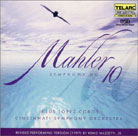February 2001
More than a few scholars have attempted to "finalize" the score by filling in the missing parts in the most Mahler-ian way possible. Of these performing editions, Derryck Cooke’s was the most successful. His version, as performed by Simon Rattle on EMI is popular -- released in the early ‘80s on a digital LP, it is still in print on CD [EMI 393939]. Remo Mazzetti's version was begun in 1983 and revised in 1997, after Mazzetti heard a performance of a different completion of the Tenth and became dissatisfied with his own. Jesus Lopez-Cobos premiered his new revised edition in Barcelona in 1999 and brought it to Cincinnati early in 2000. As Mazzetti said, "I really believe I got things right this time." The first movement is one of the most brilliant symphonic works of all time. Yet I am unhappy with the symphony as a whole, not because I am a Mahler purist, but because I think it impossible to "guess" what Mahler what would have wanted in his final version. The differences among the different performing editions bear this out. That said, Mazzetti (and Cooke, and the others) have attempted to give us a sense of what Mahler intended, which allows us to enjoy one more Mahler symphony. But other than the beautiful Adagio and the short third movement, the Tenth can hardly be considered to rank among Mahler’s best. I highly recommend that anyone unfamiliar with the Tenth seek out one of the many versions of the Adagio available and listen to it. Some of my favorites are those conducted by Solti, Tennesedt, and Walter. The success of the "completed"Tenth has as much to do with its execution as with the scoring. While the Cincinnati Symphony is probably not the first orchestra that comes to mind where Mahler is concerned, the other offerings in this series prove that Jesus Lobos-Cobos is one of the best conductors of Mahler today. One only need listen to his version of Mahler’s Symphony No. 9 [Telarc 80426], released in 1997, to confirm this. It is one of my favorite digitally recorded versions of this monumental work, although I must admit this is due, at least partially, to its excellent sonics. There is not nearly enough space to compare Mazzetti’s edition to all the others. Some scholars have made it their life-long obsession, and many a doctoral thesis has been written on the subject of the Tenth Symphony. And I did not compare versions measure-by-measure to discover which sounded more authentically "Mahler." However, I think the performance by Lobos-Cobos and the Cincinnati SO is the best version of the Tenth Symphony I’ve heard recently. Not only because of Maestro Lobos-Cobos’ prowess as a Mahler interpreter, which is obvious here, but because it is recorded with exceptional sound quality. Michael Bishop and Erica Brenner deserve to be proud of this effort. This CD is an excellent choice if one wants to hear what has become of Mahler’s last, unfinished, work. It is worth it just to listen to the Adagio once more. GO BACK TO: |
 Mahler, Symphony No. 10 in F-Sharp Minor
Mahler, Symphony No. 10 in F-Sharp Minor![[Reviewed on CD]](../format/regcd.gif) Of all
the symphonies Mahler wrote, the Tenth faces the greatest obstacles in achieving
popularity. Why? This is probably due to the fact that Mahler really didn’t write
it. His score for it was left unfinished at his death in 1911, and remained locked in a
safe until 1924. Shortly thereafter, the first and third movements -- the only completed
movements -- were performed. The rest of the score was only partially orchestrated and
most of it was in outline form.
Of all
the symphonies Mahler wrote, the Tenth faces the greatest obstacles in achieving
popularity. Why? This is probably due to the fact that Mahler really didn’t write
it. His score for it was left unfinished at his death in 1911, and remained locked in a
safe until 1924. Shortly thereafter, the first and third movements -- the only completed
movements -- were performed. The rest of the score was only partially orchestrated and
most of it was in outline form.